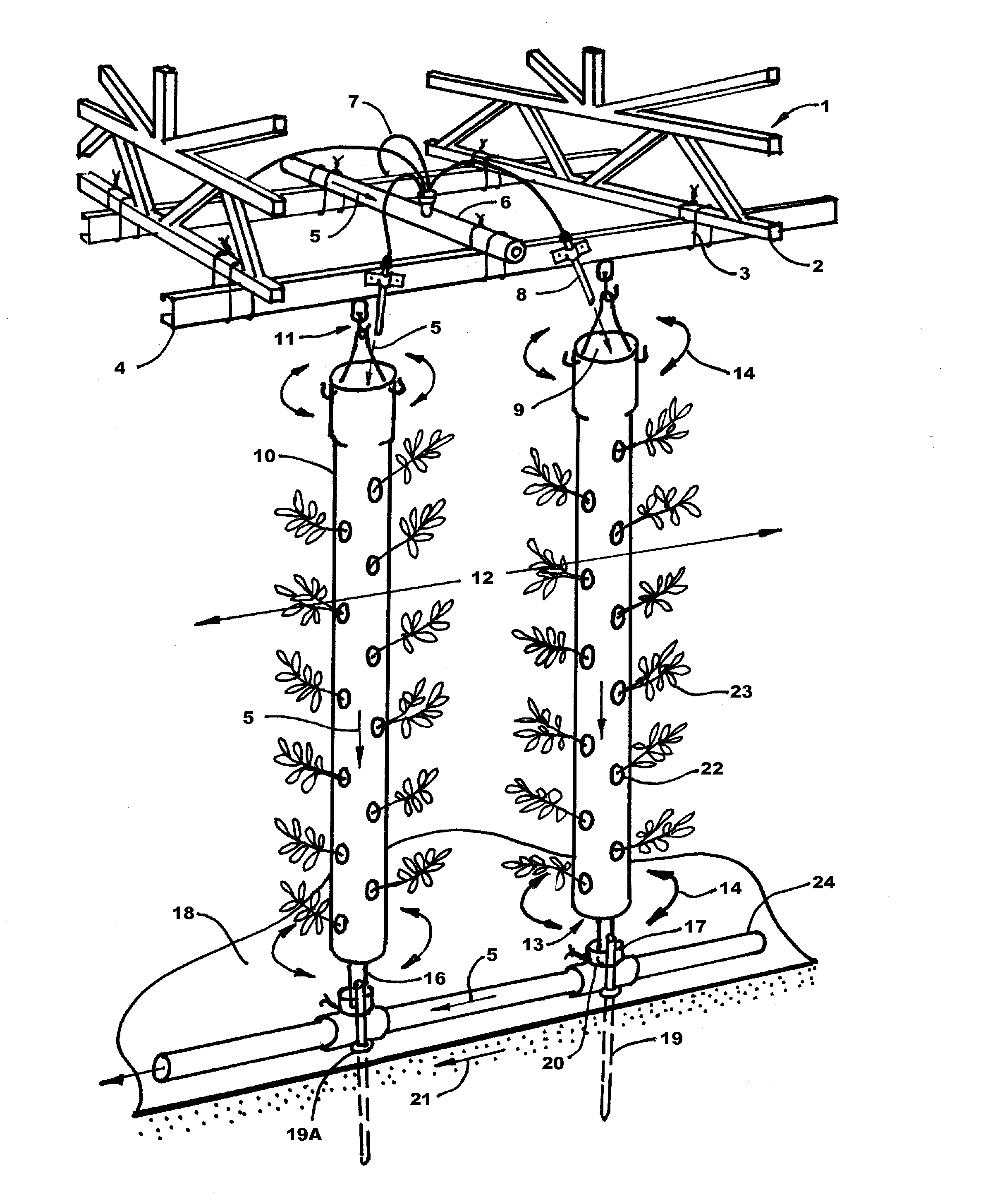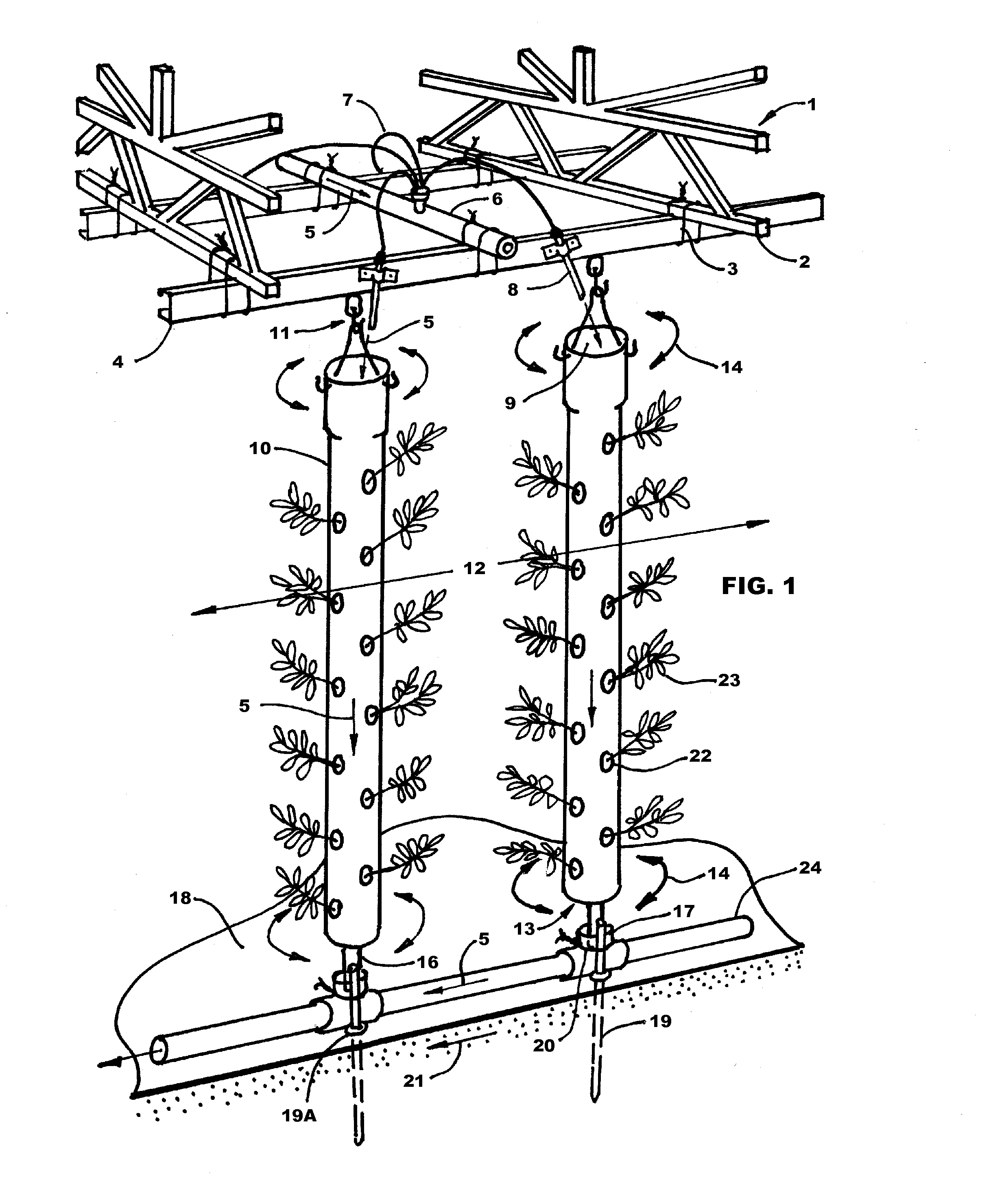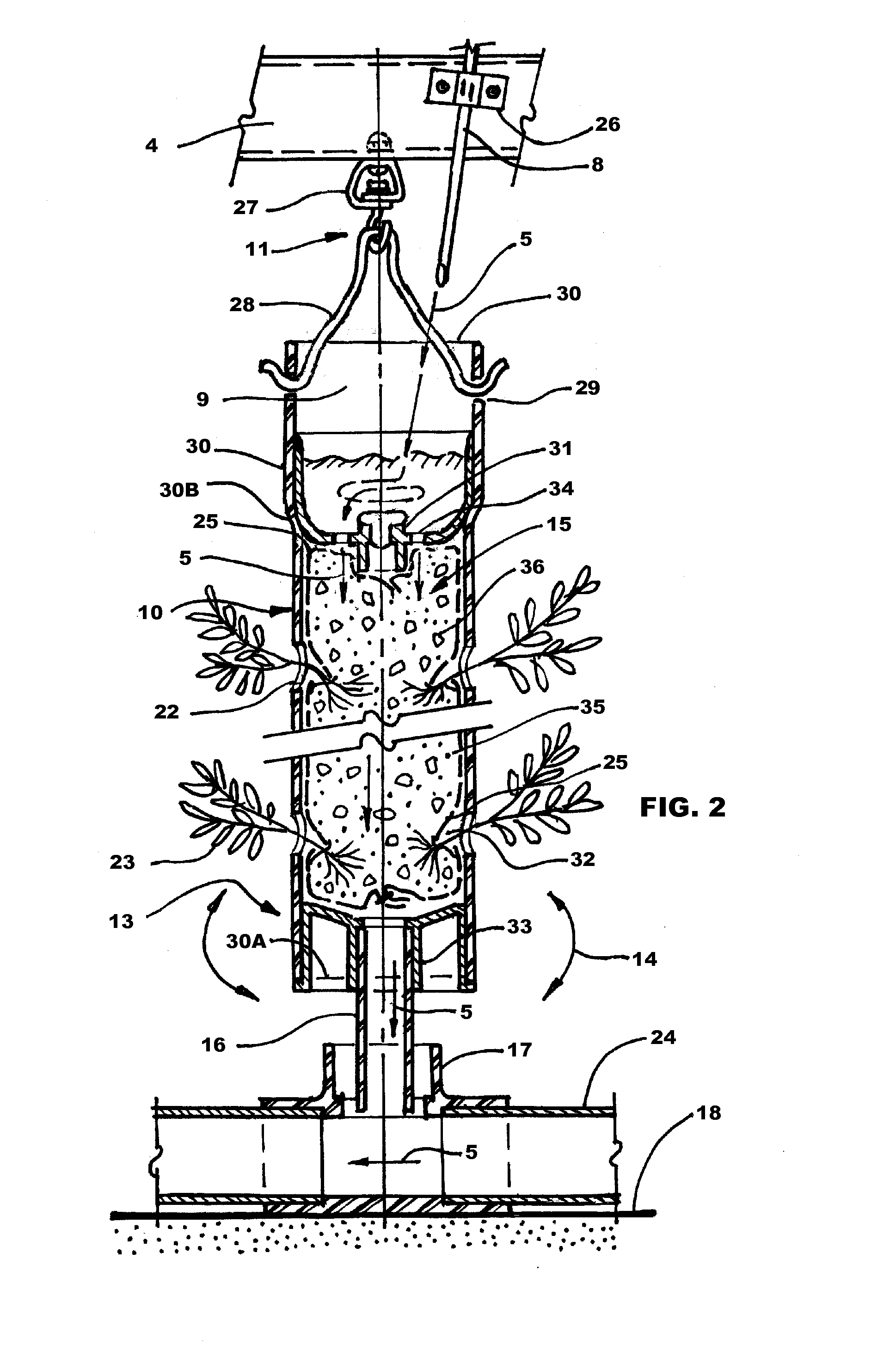1. Vertical
plant container designs are most often freestanding floor supported structures focused on the growing
system aspect and not configured in modular, adjustable, easily demountable and adaptable arrangements that use readily available affordable materials, that facilitate manufacture, transport, installation, maintenance, disassembly, rearrangement, and application to the widest possible variety of plants, crops and growing conditions.
2. Such vertical grow system designs may be used in
greenhouse enclosures, but are not usually specifically configured to integrate with modularized, transportable portable
greenhouse structures, or to permit the optional use of overhead conveyor systems in production. Floor supported designs also provide more convenient points of access for
crawling pests.
3. The weight of known grow tubes combined with the dampened weight and volume of commonly used substrate mixtures of primarily organic and secondarily inorganic grow media can limit vertical growing system heights and
plant quantities per unit of ground area due to overall apparatus size, weight and container cultivation, portability and
accessibility issues.
4. High per-unit manufacturing, installation and maintenance costs are often required due to the complexity of custom vertical plant container designs. Additionally, custom components are often not readily available or available at an affordable cost to all potential growers.
5. Known grow tube designs are often seen as being suitable for growth of organic produce while utilizing construction materials for grow tubes,
piping and fittings that are not certified as suitable for use in
potable water systems (“PW” certified), that is to say, over time some of the materials most often used may leach chemicals into the
nutrient stream at concentrations considered to be above safe limits.
6. Except for seed
germination substrate and some ground supported “lay-flat” media filled growing bags, which may utilize 100% light-weight granular inorganic grow media such as
perlite (expanded volcanic glass granules), the plant support grow media most commonly used is a mix of primarily organic and secondarily in-organic materials. The source of its organic components and the relatively large volume of substrate used for each plant can lead to conditions that support
pathogen contamination and / or an undesirable imbalance of air and
moisture, mineral salts, electrical
conductivity and / or a pH imbalance. “Lay-flat bags are typically one
crop cycle containers that are sterilized for re-use each growing cycle or discarded and do not provide an optimal, stable container
ecology for the cultivation of beneficial soil organisms and
pathogen suppression. Another related source of
pathogen contamination can be the introduction of
starter plants having been grown in soil.
7. Grow media compaction resulting from primarily organic and secondarily inorganic mix proportions and excessive
root growth can occur in commonly used substrate, leading to over-saturation and lack of sufficient air within the mixture when the media volume and composition restricts efficient
nutrient drainage and flow uniformity, thereby affecting plant and health and requiring expensive and frequent grow media replacement or sterilization to avoid
contamination of subsequent crops.
8. Use of a closed-loop fertigation and recycling system can facilitate spread of plant diseases when excessive quantities are circulated, or when the
distribution system has an excessive number of open nutrient emitter points such as at each plant grow-site, thereby multiplying potential points of entry for pests and pathogens or when the substrate retains an excessive amount of liquid nutrient between fertigation applications, or when the fertigation temperature is allowed to increase or when the recycling system does not include sufficient filtering, monitoring, analysis and adjustment to foster an optimal grow tube
ecology and to counter pathogen growth and debilitating nutrient imbalances.
Use of an excessive number of nutrient emitter points and use of conventional pressure regulating drip emitters can result in maintenance and operational inefficiencies due to clogging of emitters.
As a result of these and other factors, some commercial substrate-based growing systems presently in use have limited their application to high value vining plants such as tomatoes or cucumbers that allow for a reduction of the number of substrate container grow-sites in a vertical column to one or a few.
Also due to the above cited disadvantages, many commercial hydroponic growers have become focused on non-substrate-based hydroponic growing systems such as aqua-ponics and aero-ponics.
1. A relatively high level of grower skill, technology and operational knowledge is required for aqua-ponic and aero-ponic
agriculture systems operation, limiting their use in underdeveloped regions.
2. Vertical system heights, use of overhead support configurations or overhead conveyance means can be constrained due to apparatus and liquid nutrient weight, thereby limiting plant densities and system adaptability.
3. A relatively high per
unit cost is required for manufacturing, transport, installation, operation and maintenance due to the specialized apparatus and
continuous operation of the liquid nutrient movement, containment and delivery systems. These higher per unit costs can effectively reduce the net benefit of the extremely high plant densities claimed by some systems.
4. Because of the
closed loop aspect of continuous fertigation operations, disassembly and demounting of individual grow tubes and isolated component parts can be impeded.
5. High operational water quantities and
continuous operation are required to avoid plant
dehydration, resulting in increased
energy consumption, excessive loss to
evaporation and maintenance for the fertigation system. Use of a common liquid nutrient and constant recycling, combined with the large volumes of liquid nutrient required, can facilitate spread of plant diseases and
algae growth. Relatively large quantities of spent nutrient are also created that must be recycled, monitored, adjusted for reuse and ultimately disposed of as
waste product. The soil-less environment can support some beneficial microbial culture, but is not an optimal environment and can impede establishment of
beneficial organism dominance and suppression of pathogen development.
6. With respect to aero-ponic systems, clogging of fertigation spray nozzles can reduce
overall efficiency and increase maintenance costs.
7. Because of the relatively high cost of apparatus and high level of operating water usage, many of the known aqua-ponic and aero-ponic vertical hydroponic growing systems have been created primarily for
home use rather than for commercial use in order to command higher purchase prices, thereby limiting the value of features they may possess to commercial growers or to less affluent growers.
Various drawbacks are presented by the prior systems, primarily their high cost and unsuitability to implement on a large
commercial scale, but also their lack of focus on the creation of a growing environment suitable for cultivation of beneficial soil organisms as well as plants, lack of structural means to control the balance of air and water in the substrate, inefficient use of liquid nutrient fertigation,
excessive weight, lack of mobility, lack of adaptability and flexibility to enable reconfiguration for differing greenhouse configurations, plant types, climates, grower and
market needs.
The disclosed
ceramic pots with vertical rotation and floor-mounted support frames would have limited flexibility for reconfiguration, be heavy and relatively expensive to construct, and result in a high cost per vertical grow-column unit; (2) Disneyland Epcot Center
Hydroponics Greenhouses, Orlando, Florida, available for public tours and published on multiple internet sites, including , discloses large
diameter hollow vertical PVC “column pots,” used for a
hydroponics exhibiting rather than for commercial growing, suspended from overhead conveyor tracks and provided with an internal aeroponic spray fertigation system with waste discharged on the ground.
 Login to View More
Login to View More  Login to View More
Login to View More 


